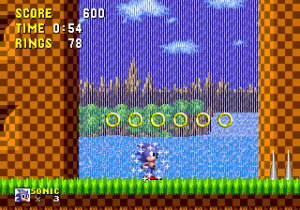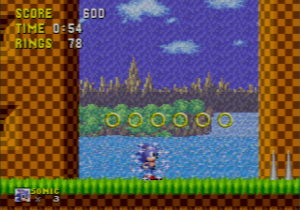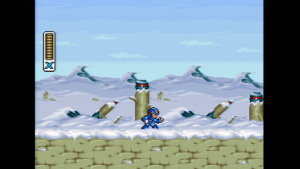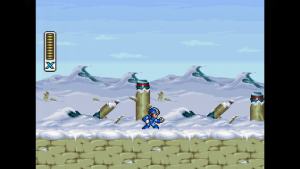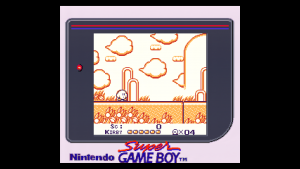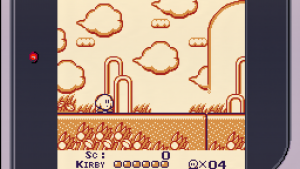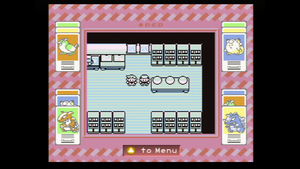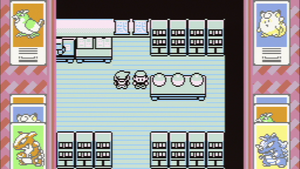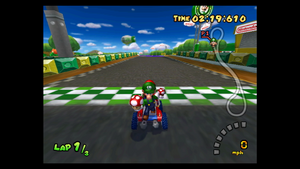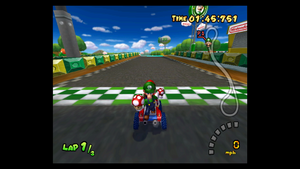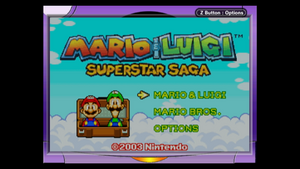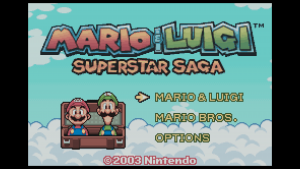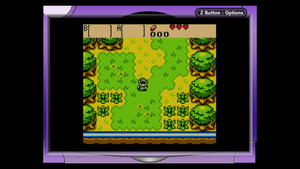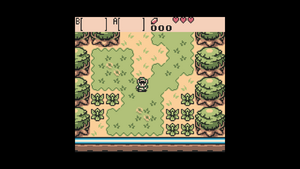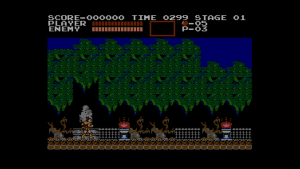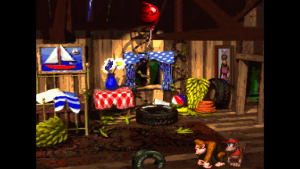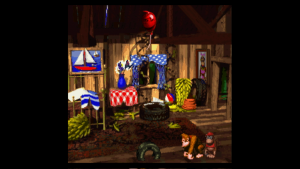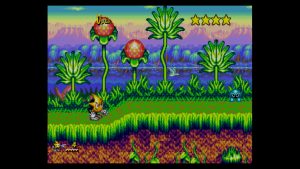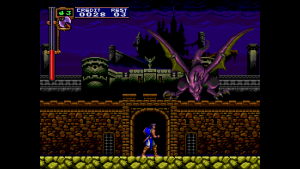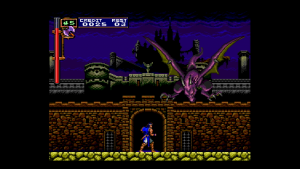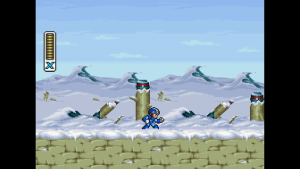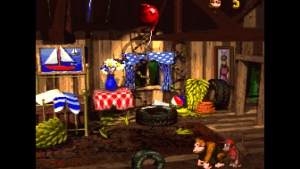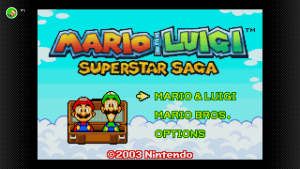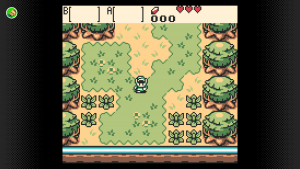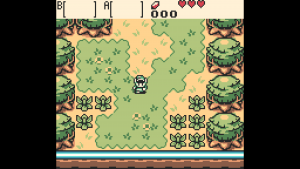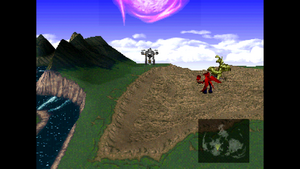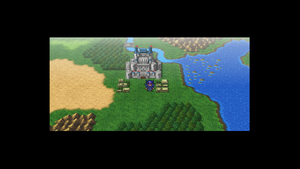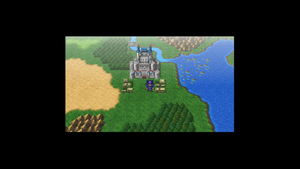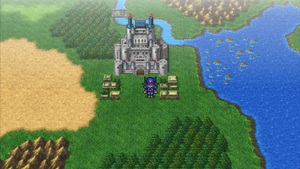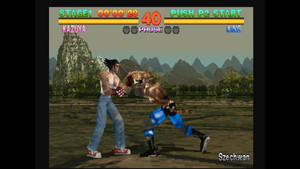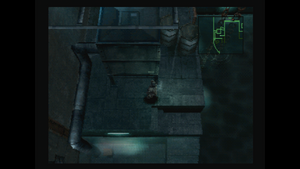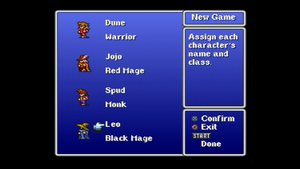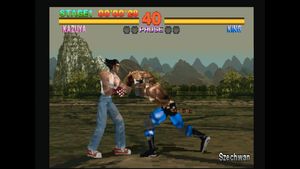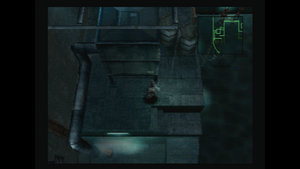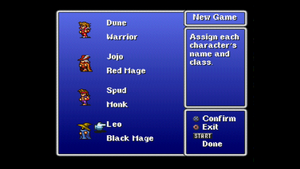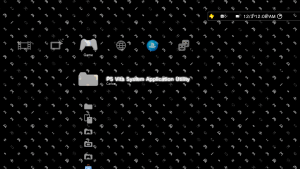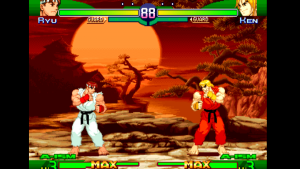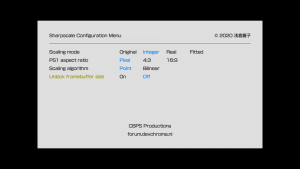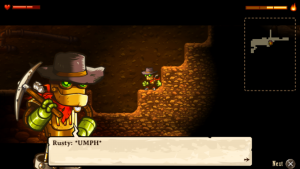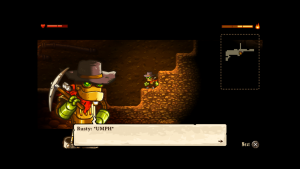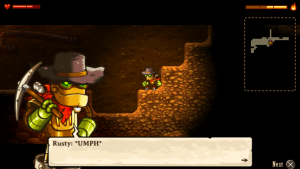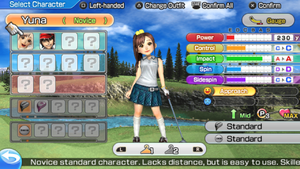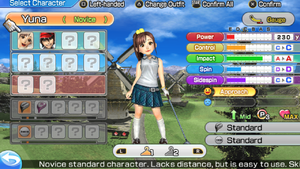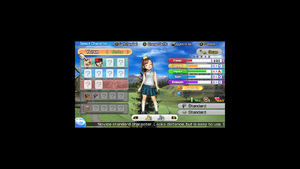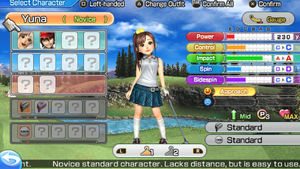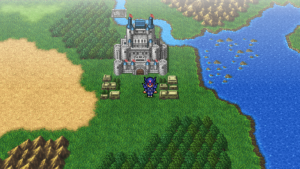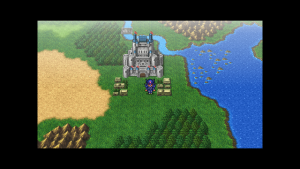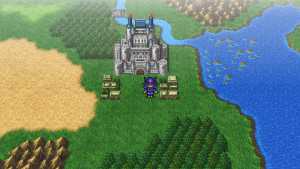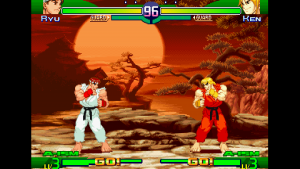AV:RetroTINK-4K/System Specific Settings
The System-Specific Settings page is all about highlighting how you can use the RetroTINK-4K's various features to improve the experience of using your video game systems beyond just plugging them in. This can range from setting 1:1 pixel aspect ratio for Super Game Boy on the SNES, to dovetailing with the Sharpscale Plugin on the PlayStation TV. While the RT4K will always provide a great experience right out of the box, the tips in this section will help remove quirks and annoyances from the original platform, or present the games more accurately.
| Every section will have a section with a chart that lays out how to achieve the optimal and sharpest settings for that console. For analog consoles that utilize the RGB/Component ADC Setup, you will need to use Enhanced S-Video, YPbPr Component, RGBS, or RGBHV. These will not work with S-Video or CVBS Composite, as those do not have sampling settings. |
For general information about the RT4K, please visit this page.
Automatic Sampling Detection vs Manual Sampling Detection
At the start of your console's section, you may see "Sample Rate Detection" noted in the optimization graph. This means the console cam make use of the Automatic Sampling Detection feature of the RetroTINK-4K for 15KHz signals. If your library regularly uses multiple horizontal resolutions for their 15KHz signals, consider taking advantage of Automatic Sample Rate Detection. If your console uses multiple horizontal resolutions but your library only makes use of one, consider using the Manual Sample Detection settings instead. One example would be Super NES: an overwhelming majority of games use 256px for their horizontal resolutions and very few use 512px. Even if you do have a game that uses 512px, you may find operating the RT4K easier by forcing 512px.
Defeating Dithering
Dithering is a technique many games used in tandem with the blurring effect of a video cable (like Composite) and a CRT. The idea is that the video cable and display blend the dither patterns together, to accomplish tricks like transparency or higher color depth. When using high-quality cables like RGB-SCART and Component, dithering can become very apparent, and many users may find them unsightly. The RetroTINK-4K has an option that can help:
- Go to Advanced Settings > Processing / Effects, then set Hori. Kernel and Vert. Kernel to "Bilinear Soft" as needed. This blurs the edges of the pixels to disguise the dithering.
The cost of applying this effect is that the image will of course be rather blurry. Adding some scanlines (also in the Processing / Effects menu) can help alleviate this somewhat; don't forget that HDR will help brighten the image back up. If the dithering is only vertical stripes (like the waterfalls in Sonic the Hedgehog or the water in Kirby's Dream Land 3), you could alternately use Bilinear Sharp on the Hori. Kernel, for a slightly sharper appearance.
| Sonic the Hedgehog - Bilinear Sharp Vert. and Hori. | Sonic the Hedgehog - Bilinear Soft Hori. | Sonic the Hedgehog - Bilinear Soft Hori. with Scanlines |
|---|---|---|
Nintendo Systems
NES / Famicom
| RGB/Component ADC Setup (256) | ||
|---|---|---|
| Samples per Line | 3410 (2861 Act) | |
| Decimation Factor | 10 (341.000) | |
The Famicom (or Family Computer) is the original Japanese version of Nintendo's landmark console, while the NES (or Nintendo Entertainment System) was released in all other regions. All Famicom / NES systems will be marked as such on the front, so simply read that to tell which one yours is (particularly useful regarding the top-loading redesigns). These systems render games in 256x224.
- The NES family renders and outputs all audio in mono via the white RCA jack (left speakers). To account for this, go to Advanced Settings > Audio Setup, then set Input Swap to "Mono (Left)".
- Some NES family games, like Super Mario Bros. 3, have visual errors visible on the left and right sides of the screen. These can be removed from view using the cropping tools.
The NES / Famicom can only output either Composite video or RF (with one rare exception). You will need at least a composite signal to connect directly to the RT4K. Use the list below to tell which one your system outputs:
- Composite signals are supported by the RetroTINK-4K. This can be used on either the front yellow plug, or the rear green plug.
- Original "Front-loading" NES (NES-001).
- Top-loading "AV Famicom" with the rounded power switch and flat cartridge slot.
- Sharp's "Twin Famicom".
- Sharp's "Famicom Titler" (also capable of S-Video).
- RF signals are not normally supported by the RetroTINK-4K. These models support RF output:
- Original Famicom w. hard-wired controllers.
- Revised "Top-loading" NES with a rounded cartridge slot and power switch.
- The RF Modulator output from the original "Front-loading" NES-001, which has softer sound compared to the the sharper Composite output.
Super NES / Super Famicom
| RT4K Settings | ||
|---|---|---|
| Sample Rate Detection | ||
| Auto Dec. Factor | Yes | |
| Audo Dec Phase | Yes | |
| ADC Sample Rate | 3410 | |
| Progressive Detection | 341.000 | 682.000 |
| Manual Sample Detection (256) | ||
| RGB/Component ADC Setup (256) | ||
| Samples per Line | 3410 (2861 Act) | |
| Decimation Factor | 10 (341.000) | |
| Manual Sample Detection (512) | ||
| RGB/Component ADC Setup (512) | ||
| Samples per Line | 3410 (2861 Act) | |
| Decimation Factor | 5 (682.000) | |
The majority of Super NES / Famicom games run in 256x224 resolution, while a select few games run with a mix of the following: 512x224 in the whole screen for menus, 256x224 for most of the image while running 512x224 over certain parts of the screen to create transparency effects, or the same but using 512x224 resolution to allow sharper text on the screen. It is recommended to run the Super NES in 512x224p mode to make sure you get all available detail.
[pending screenshots of Trials of Mana or Kirby game with 512 mode vs 256 mode]
This topic is a WIP, please see the same topic on the RT5X wiki
(https://consolemods.org/wiki/AV:RetroTINK-5X_Pro#512_%22Hi_Res%22_Games)
We recommend using a Super NES model number SNS-001, or Super Famicom model number SHVC-001, and an RGB SCART cable wired for Sync-on-Luma, as this works with both of the aforementioned models. There are internal revisions of these models, noted as "1-Chip" on the motherboard, and the 1-Chip-03 does not work with Composite Sync. There is a revised model, SNS-101 and SHVC-101, also known as the Super Nintendo Junior.
As noted, there are revisions of the original model Super NES, noted by the "1-chip" on the motherboard. The 1-chip boards have sharper yet brighter video, while the non-1-chip boards have a "smeared" and slightly darker look. We encourage using the auto-gain functions in the ADC to correct the video on both models.
| Non-1-Chip | 1-Chip |
|---|---|
For your convenience, there are profiles included for automatic switching between 512 and 256 in Display Aspect Ratio, for both SCART and HDRV YPbPr cables.
Super Game Boy
| RGB/Component ADC Setup | Super Game Boy 09x | Super Game Boy 15x | |
|---|---|---|---|
| Samples Per Line | 3410 (2861 Act.) | ||
| Decimation Factor | 10 (341.000) | ||
| Scaling/Crop Setup | |||
| Aspect Correction | 1:1 (Sq. Pixel) | ||
| Scaling Mode | Auto Fill Integer or Proportional | ||
The Super Game Boy Cartridge allows you to play original style Game Boy and Game Boy Color cartridges on your TV using the Super Nintendo, and adds borders. Once dialed in, Game Boy games are rendered in a 160x144p window inside a 256x223p canvas. However, Game Boy games were expected to be displayed on the square pixels of their screens, unlike the rectangular CRT pixels that the SNES expects.
- For correct Super Game Boy pixels, go to Advanced Settings > Scaling/Cropping, then set Aspect Correction to "1:1 (Sq. Pixel)".
For your convenience, there are profiles included to maximize the Game Boy window to the screen, or 15x the original GB pixel count.
Nintendo 64
| RGB/Component ADC Setup | |
|---|---|
| Samples per Line | NTSC: 3094 (2596 Act.
PAL: 3176 (2646 Act.) |
| Decimation Factor | NTSC: 4 (773.500)
PAL: 4 (794.000) |
Unfortunately, no stock Nintendo 64s support RGB without modding the console. All stock N64s support Composite, all NTSC N64s support S-Video, French N64s support SECAM S-Video, and some PAL N64s do not support S-Video at all.
All N64s have 3 levels of video processing that keep it from being as sharp as the PlayStation and Saturn:
- All games scale their image to 640 pixels wide. Many games were rendered at different resolutions but the N64 will scale to 640.
- Many games render at 320 pixels wide and, as a trick, you can double your ADC Decimation factor to "correctly" render games in their original resolution. This trick only works for games that render at 320 pixels wide, and do not work for games that render at other resolutions that are not 320 or 640 pixels wide.
- Software level anti-aliasing. This can be disabled by patching ROMs or using a Gameshark to disable the effect.
- Hardware level anti-aliasing. This can't be disabled without a physical mod.
[Picture Here: AA enabled vs AA disabled]
[Picture Here: a 320 game with the trick used vs left at 640 (should be the same)]
[Picture Here: a non-640 or 320 game with the trick used (should look worse)]
Pokémon Stadium Game Boy Tower
| RGB/Component ADC Setup | Scene | GameBoy Tower
N64 Optimal 4:3 |
GameBoy Tower
N64 Optimal Stretched |
GameBoy Tower
Square Pixel Estimation | |
|---|---|---|---|---|---|
| Samples Per Line | 3094 | Overworld | |||
| Decimation Factor | 9 | ||||
| Scaling/Crop Setup | |||||
| Scaling Mode | Free-Form | Status
Screen |
|||
| Vert. Factor | 15.00x | ||||
| Hori. Factor | 15.000x | ||||
Pokémon Stadium's GameBoy Tower allows you to play Pokémon games on your TV, similar to a Super Game Boy, and even uses the Super Game Boy borders. The issue, however, is the scaling noted in the section above. These games render at 160x144p inside a 256x223p canvas, which is then scaled to 640 pixels wide. You will not get a sharp picture out of this setup due to that factor alone. If you wish, follow the settings noted above to approximate a GameBoy's square pixels.
Nintendo GameCube
| HDMI Receiver Setup | |
|---|---|
| 4:2:2 Upsampler | Linear |
| RGB/Component ADC Setup | |
|---|---|
| Samples per Line | NTSC: 3432 (2880 Act.)
PAL: 3456 (2880 Act.) |
| Decimation Factor | NTSC: 4 (858.000)
PAL: 4 (864.000 |
For the purposes of use with the RetroTINK-4K, it is highly recommended to use a DOL-001 GameCube, which has the digital out port, and an Insurrection Industries Carby, which outputs crisp digital video and can connect to the HDMI® input port of the RT4K. If you insist on buying YPbPr cables, we can only recommend the OEM D-Terminal cable with a D-Terminal to Component adapter, or the OEM component cable. PAL GameCubes can utilize SCART regardless of model number, but are normally limited to 15kHz video modes.
Most GameCube Games will run at 480p: progressive mode is activated by holding B when the GameCube boots up a game.
The following settings require a GameCube capable of running Swiss and GCVideo 3.1 HDMI Output.
GCVideo and Settings
Adjust the following settings in your GCVideo device:
- Scanline Profile: Off
- Output Settings
- Enhanced DVI Mode: On
- Display as 16:9: Off
- Volume: 255
- View All Modes (all settings)
- Line Doubler: Off
- Scanline Profile: Off
- Advance Settings
- Chroma Interpolation: Off
- Fix Resolution: Off
- Fix Sync Timing: Off
- Regenerate CSync: Off
- Digital Color Format: YC422
- Report 240p as 480i: Off
- Sample Rate Hack: Off
Swiss Settings
These settings were tested on Swiss v0.6r1664 with a GCVideo HDMI device. Adjust the following setting in Swiss:
- Optimise for RT4K: On
The following games require horizontal scaling adjustment under this configuration. If there is a game you do not see on this list that has a major change, please report it to the RT4K Discord
- The Legend of Zelda: Wind Waker
- Star Wars: Rogue Squadron
- Super Smash Bros: Melee
| Default output | Force Horizontal Scale - 1:1 | 1:1 horizontal + aspect ratio correction
GCVideo Fix Resolution set to off RT4K set to Aspect Correction: 4:3 |
|---|---|---|
Anti-Flicker Filter
Many GameCube Games apply an Anti-Flicker filter, which was designed to help with interlaced video content, even on 480p games. You must use software patches to disable this effect. This effect is automatically disabled with Swiss when loading a game.
240p Games
There are two GameCube games that run at 240p: Megaman X Collection, and the NES games in the Zelda Collector's Edition Promotional Disc. This means you do not have to enable 480p to run those games and can sharply scale these games on the RT4K.
| Game | Original | GameCube Unoptimized | GameCube Optimized |
|---|---|---|---|
| Megaman X | pending photo |
Game Boy Player + Game Boy Interface
| RT4K Settings | Console | GameBoy Player Disk | Old RetroTINK-5X Method using
GBIHF-OSSC at 1080p |
GBIHF-RT4K-HDMI | |
|---|---|---|---|---|---|
| GameBoy Advance | |||||
| HDMI® Output | |||||
| Sync Lock | Gen | ||||
| HDMI® Receiver | |||||
| Input Pixels | 2 (Output: 240p) | ||||
| 4:2:2 Upsampler | Nearest | ||||
| Input Range | RGB Lim. | ||||
| Scaling/Crop Setup | |||||
| Vert Prescale | 1/2 | GameBoy Color | |||
| Aspect Correction | 1:1 (Sq. Pixel) | ||||
| Scaling Mode | Auto Fill Integer | ||||
| Color Correction Setup | |||||
| Input Factor | 2.4 | ||||
| Output Factor | 2.4 | ||||
| Bit Crush | 3 bits Removed | ||||
The Game Boy Player is a popular add-on to the GameCube that allows you to play Game Boy, Game Boy Color, and Game Boy Advance games on your TV. The Game Boy Player Disk does not sharply render games onto the screen, but you can use the homebrew software Game Boy Interface to sharply render games into the RT4K. A specific flavor of GBI was created to take advantage of the Insurrection Industries Carby and the TINK 4K's HDMI® Input. Please use files gbihf-rt4k-HDMI.cli, gbihf-rt4k-HDMI.dol+cli or gbihf-rt4k-HDMI.gci included with GBI and follow the instructions noted here.
For your convenience, there are profiles included for sharp integer scaling of both GBA and GBC games.
Nintendo Wii
| RGB/Component ADC Setup | |
|---|---|
| Samples per Line | NTSC: 3432 (2880 Act.)
PAL: 3456 (2880 Act.) |
| Decimation Factor | NTSC: 4 (858.000)
PAL: 4 (864) |
The Nintendo Wii is a very versatile console: it plays GameCube Games, Wii Games, and many classic retro titles through emulators as part of the Virtual Console lineup. The Wii also has easy to find YPbPr component cables and can easily support 480p across all Wii software through its component cables, making it a popular option for playing GameCube games. The Wii only supports 5 resolutions: 720x240p, 720x288p, 720x480i, 720x576i, and 720x480p. Please read on for more information on getting the sharpest possible picture from a Wii.
For your convenience, there are profiles included for basic sharp output. It is recommended you use this for basic Wii use.
Virtual Console
Many Virtual Console games output at 240p when the Wii is in SDTV mode, and they will line double to output at 480p in EDTV mode. All virtual console games scale the image to 640 pixels wide, so it is recommended you use the default or generic profiles for playing virtual console games.
| NES Virtual console games are rendered many shades darker than an original console, as an anti-epilepsy measure. |
| Console | Original Console Optimized | Virtual Console Default Settings |
|---|---|---|
| NES | [pending Screenshot
Castlevania NES] |
|
| Super NES | ||
| Sega Genesis | [Pending Picture of Ristar on Genesis 10x DAR] | |
| Turbo Grafx-16 | ||
| NEO GEO | NEO GEO Game | NEO GEO Game |
USBLoader GX, and Counteracting the Anti-Flicker Filter, 480p Fix, and the Framebuffer Video Width
Homebrew called USBLoader GX allows you to activate or deactivate code before running games, even on your disks.
Most Wii games will apply an anti-flicker filter, even at 480p, which results in a softer picture. Use USBLoader GX's options to turn this off for Wii Games. If you wish to run GameCube games, you will need to turn the anti-flicker filter off separately in either Nintendont or Devolution, but USB-Loader GX does have these options in its menu.
[Video here: Super Smash Bros Brawl's settings menu turning the anti-flicker filter on and off]
There is an option in USBLoader GX called the "480p pixel fix" which makes the game look sharper. It only works with RVL-001 models with the internal CPU-01 motherboard. Click here for a buying guide as well as the steps for using the Wii 240p Test Suite to confirm if your Wii is compatible with the 480p fix.
[Picture here: Wii game with 480p pixel fix off vs on]
You can get even sharper picture from the Wii by enabling the "Video Width: Framebuffer" option in USBLoader GX. This will make games output in their original rendering resolution, which you can then rescale using the RT4K to get a much sharper picture than originally intended at the "correct" aspect ratio. As an added bonus, NES and Super NES games will render at 512x224p with this option turned on, which you can use a doubled decimation factor to treat a game like its original 256x224 resolution, and get picture on par with their original consoles.
| Super NES Game Optimal Sampling DAR | Wii Virtual Console Default Settings | Wii Virtual Console, Video: Framebuffer |
|---|---|---|
Wii GCVideo Based HDMI Devices (WiiDual, etc.)
These are some recommended settings. Please remember to select "Store Settings" in the GCVideo menu to save your settings or not. These settings are based on the WiiDual but should be similar for AVE-HDMI. Wii GCVideo based devices are not affected by the 480p LPF issue. If you are using system specific profiles, please refer to the instructions included with the profiles.
WiiDual firmware 3.1
- Output Settings:
- Allow 480p Mode: On (Please make sure in the Nintendo Wii settings menu that 480p is enabled)
- Enhanced DVI Mode: On (or else there won't be audio)
- Display as 16:9: On or Off (Make sure this setting corresponds with what is in the Nintendo Wii video settings menu.)
- View all Modes:
- 240p, 288p, 480i, 576i Linedoubler: Off (Let's the Tink4k handle all upscaling and deinterlacing)
- Advanced Settings:
- Chroma Interpolation: Off (Safe to set to off, as it has no effect if you're using YC422, see below)
- Fix Sync Timing & Regenerate Csync: Off (Safe to leave as off, turn on if it fixes your issues)
- Fix Resolution: Off (Safe to set to off if you are using default Tink4K profile, otherwise please see txt on sdcard of specific profile maker)
- Digital Color Format: YC422 (This matches what the Wii internally uses)
- Report 240p as 480i: Off
- (Audio) Sample Rate Hack: Off (Safe to keep off, this tries to fix audio issues when enabled)
Games that only support 4:3 or 16:9
In general, the "Aspect Correction" setting should be set to either 4:3 or 16:9 depending on your Wii's system settings and preferred display mode. Most games support both modes natively, however some titles only support one or the other, and pad the unused area with black bars. "16:9-only" titles will display as letterboxed when the Wii is set to 4:3, with black bars on the top and bottom of the screen. "4:3-only" titles typically pillarbox the image when the Wii is set to 16:9, with black bars on the left and right of the screen- some 4:3-only games, such as Wario Land: Shake It!, will pillarbox with border artwork or game information, while the active "playing area" will remain roughly 4:3 after the image is stretched.
Due to the nature of anamorphic widescreen, it is recommended that you change your Wii's system setting (and the Tink's Aspect Correction setting) if it doesn't match one of these games, so that you aren't losing resolution to letterboxing or pillarboxing. Most known titles are listed in this thread
There are some other options if you don't want to change your settings back and forth for these titles, but still want the full resolution:
- If you use USBLoaderGX, you can change the aspect ratio setting per-game, so that the Wii will automatically switch settings when the game is launched. Keep your general setting in the Wii's menu on the aspect ratio you prefer and only change it per-game in USBLoaderGX if they do not match.
- Some Gecko codes are available to force popular 16:9 only titles into 4:3 if you prefer, usually by expanding the visible vertical area. These may have varying degrees of success to various widescreen hacks, with potential issues such as object pop-in, stretched or misplaced UI elements, and framerate issues from the increased rendering load. These codes are generally available on the Dolphin Wiki , with some screenshot examples in this thread
Nintendo Wii U
It is highly recommended to use the Wii U's HDMI® output instead of its Component output. This is because the analog video is duller, and has less sharpness (even compared to Component from the PS3 and 360).
[Insert Picture: HDMI Vs YPbPr]
- The Wii U's HDMI® only outputs in limited range. To account for this, go to Advanced Settings > HDMI® Receiver, then set Input Range to "RGB Lim.".
Wii Backwards Compatibility
The Wii U is backwards compatible with Wii and offers HDMI Output. There is a 1% scale of wii games, even outputting 480p. While you can use custom firmware to reverse this, it currently results in an offset chroma. If you can find a Wii that works with the 480p patch, it is recommended to use that over a Wii U.
[Insert Picture: Wii YPbPr vs Wii U 480p]
Nintendo Switch
Nintendo Switch Online Games
it is highly recommended to use 1080p output for the NSO emulators and turning on "Pixel Perfect" in their settings under "Game Screen" and to also turn off "Show controls in game" under "Control Display," and to turn off "reproduce classic feel" on the Game Boy and Game Boy Advance apps. This way, all games output a perfectly integer scaled, line-multiplied output for their games.
For your convenience, there are profiles that will optimize NTSC NSO titles played through the RT4K.
| Console | Original Console DAR 10x | NSO No Changes | NSO Optimized |
|---|---|---|---|
| NES | |||
| Super NES | |||
| Sega Genesis | [Pending Ristar Genesis DAR Screenshot] | ||
| GameBoy Advance | |||
| GameBoy Color |
SEGA Systems
SEGA Master System
The original model of the Master System supports Composite and RGB output (S-Video is not supported without mods). The second model, the "Master System II", cannot be used with the RetroTINK-4K without modding, as it only supports RF output.
- Master System games are infamous for having borders of solid colour around the game graphics. These can be removed by going to Advanced Settings > Scaling/Cropping and using the Input Crop trim tools, but be mindful! Master System games can use two horizontal resolutions: 248 pixels and 256 pixels, and some games will use both of them. The safest option is to crop to a 256 pixels wide screen, which will leave a column on the left-hand side of 248 pixels wide screens. You could also have an additional profile just for 248 pixels wide screens.
- The Auto Crop tools will not work here, as they will consider the colored border to be part of the image (it technically is, if still unsightly).
- The Master System also has rather dim video output compared to other systems. You can fix this by going to Advanced Settings > RGB/Component ADC and adjusting the Gain while using the 240p Test Suite. You can also use the Auto Calibrate Gain feature, which works best if there's a patch of solid, pure white somewhere on the screen.
SEGA Genesis / Mega Drive
| Sample Rate Detection | ||
|---|---|---|
| Auto Dec. Factor | On | |
| Auto Dec. Phase | Auto | |
| ADC/Sample Rate | 3420 dots/line | |
| Progressive Detection | 342.000 | 426.500 |
| Manual Sample Detection (256) | ||
| RGB/Component ADC Setup | ||
| Samples per Line | 3432 (2850 Act.) | |
| Decimation Factor | 10 (342.000) | |
| Manual Sample Detection (320) | ||
| RGB/Component ADC Setup | ||
| Samples per Line | 3432 (2850 Act.) | |
| Decimation Factor | 8 (429.000) | |
Recommended output: RGB
For practicality, "Genesis" refers to both the SEGA Genesis and the Mega Drive (it's Japanese and European name), as they are functionally identical as far as the RetroTINK-4K is concerned, outside of NTSC and PAL standards.
- The SEGA Genesis has two 240p output resolutions: 320x224 and 256x224. A third resolution, 480i, is only known to be used in the 2 Player VS modes of Sonic the Hedgehog 2 and Combat Cars.
Certain Genesis games will display colored dots along the bottom edge of the screen. Known as CRAM (Colour RAM) dots, these would have been in the overscan area of most CRTs and thus invisible to the player, but are quite prominent on modern displays. You can hide them by going to Advanced Settings > Scaling/Cropping and adjusting the Bottom Trim value. You should not use Auto Crop, as it will consider the CRAM dots to be the bottom edge of the picture.
Composite effects. see this portion of the 5x wiki https://consolemods.org/wiki/AV:RetroTINK-5X_Pro#Genesis_Dithering
SEGA CD
SEGA 32x
Master System Games on Genesis
SEGA Saturn
| Manual Sample Detection (320) | |
|---|---|
| RGB/Component ADC Setup | |
| Samples per Line | 3416 (2866 Act.) |
| Decimation Factor | 8 (427.000) |
| Manual Sample Detection (352) | |
| Samples per Line | 3640 (3054 Act.) |
| Decimation Factor | 8 (455.000) |
| Manual Sample Detection (640) | |
| Samples per Line | 3416 (2866 Act.) |
| Decimation Factor | 4 (854.000) |
| Manual Sample Detection (704) | |
| Samples per Line | 3640 (3054 Act.) |
| Decimation Factor | 4 (910.000) |
Recommended output: RGB
SEGA Dreamcast
The Dreamcast can output RGBHV via VGA for 480p enabled titles and can use RGB SCART otherwise. There are third-party 480p capable SCART cables available for the Dreamcast. Please see this site for more information
DCDigital/DCHDMI (first gen/HW1)
These settings are for first gen DCDigital/DCHDMI only. Second gen and GEM versions may not match the following or have expanded capabilities. Also, this assumes the default Tink4K profile. If you are using specifically made profiles, please refer to the instructions included with those profiles.
- Firmware 4.7std: for games with native VGA support or can be forced for VGA
- Output Resolution: VGA
- Advanced Video Settings:
- Deinterlacer 480i & 576: passthru
- 240p adjust position: off
- VGA adjust position: auto
- RGB color space: full
- Video Mode Settings: Force VGA/Switch Trick VGA
- Firmware 4.7std: for games that can't be forced into VGA such as Marvel vs Capcom, JoJo, Plasma Sword, Last Blade 2, etc.
- Output Resolution: 480p
- Advanced Video Settings: (same as above)
- Video Mode Settings: Cable Detect
PlayStation Systems
Sony PlayStation
| Sample Rate Detection | |||||
|---|---|---|---|---|---|
| Auto Dec. Factor | On | ||||
| Auto Dec. Phase | Auto | ||||
| ADC Sample Rate | 3413 | ||||
| Enable | 341.300 | 426.624 | 487.571 | 682.600 | 853.250 |
All Sony PlayStation models support RGBS. It is recommended to use a well shielded SCART cable that uses Sync-on-Luma.
For your convenience, included are included for optimal picture from PS1 games, but please read below for some additional information regarding PS1 games and their behavior, and settings tweaks you may want to make.
Horizontal Resolution Switching + Automatic Sample Detection
The PlayStation utilizes up to 5 horizontal sample rates and many games will consistently change sample rates between scenes, usually between gameplay and menus. Depending on your setup, you may need to turn off certain sample rates if your games do not use them. Though incomplete, consider consulting with and contributing to this growing list of PS1 games and their horizontal resolutions to see if your library can work with a trimmed down sample rate list.
Vertical Resolution Switching
There are some PlayStation games that will switch between 240p and 480i during regular gameplay. On these games, consider making your way to the RT4K HDMI Output menu and switching Sync Lock to "Triple Buffer" mode so you do not lose out on gameplay during these switches. Included profiles are usually set to Triple Buffer by default.
Sony PlayStation 2
| Sample Rate Detection | |||||
|---|---|---|---|---|---|
| Auto Dec. Factor | On | ||||
| Auto Dec. Phase | Auto | ||||
| ADC Sample Rate | 3432 | ||||
| Enable | 343.200 | 429.000 | 490.286 | 686.400 | 858.000 |
| Sample Rate Detection | |||||
|---|---|---|---|---|---|
| Auto Dec. Factor | On | ||||
| Auto Dec. Phase | Auto | ||||
| ADC Sample Rate | 3456 | ||||
| Enable | 345.600 | 432.000 | 493.714 | 691.200 | 864.000 |
The PS2 outputs 240p, 480i, 480p, and 1080i, and supports RGB as well as YPbPr. For simplicity, it is highly recommended to use YPbPr cables because the RT4K will automatically detect and switch to all those resolutions seamlessly. The PS2 will use RGBS for 240p and 480i, but will switch to RGsB for any resolutions above that. While the RT4K supports RGsB, it does not automatically switch from RGBS to RGsB, you will need to change the input manually.
For your convenience, there are profiles included for the sharpest picture from a PS2. All PS2 games will output either 512 pixels wide or 640 pixels wide. [sic]
| Make sure your PS2 is outputting the signal that matches what input you are using, which can be adjusted in the PS2 "System Configuration" menu when you turn on the PS2 without a game inserted. If you need to navigate this menu blind, you can find instructions here: https://consolemods.org/wiki/PS2:Resetting_Component_Video_Out_Setting |
| If you are using SCART cables, you can set your PS2 to output YPbPr and set the RT4K to accept YPbPr through the SCART input. for more information see the inputs section. https://consolemods.org/wiki/AV:RetroTINK-4K#SCART |
PS1 Backwards Compatibility
The PS2 does not perfectly render PS1 games the same way a PS1 would. Using a different graphics chip and different timings results in subtle differences in the way graphics are drawn, and therefore require different settings than what you would use on a PS1 playing the same game. Subtle differences between PS1 consoles and PS2 consoles playing the same games result in additional dithering or incorrect transparency effects. PS1 games play identically on both consoles otherwise.
Otherwise, PS1 games on PS2 may need similar considerations to horizontal sampling rate detection and vertical resolution changes. Please read the linked sections to find out more.
For your convenience, there are profiles included for playing PS1 games on PS2.
| PS1 Optimization on PS1 | PS1 on PS2 using PS1's Optimization Settings | PS1 on PS2 optimized using PS2's Optimization Settings |
|---|---|---|
Sony PlayStation Portable
| RGB/Component ADC Setup | |
|---|---|
| Samples per Line | 3432 (2880 Act.) |
| Decimation Factor | 4 (858.000) |
| Scaling/Crop Setup | |
| Top & Bottom Trim | Edge of game picture minus 2 pixels from top or bottom |
| Left & Right Trim | Edge of game picture |
| Aspect Correction | 1:1 (Sq Pixel) |
| Scaling mode: | Auto Fill Integer |
PSP models PSP-2000, PSP-3000, and PSP-N1000 (aka PSP GO) can output to a display. It is highly recommended you use YPbPr component cables with the RT4K.
Do the following in the "Connected Display Settings" page in the menu:
- Set "Component/D-Terminal Output" to Progressive
- Select "Switch Video Output" and select "Yes" if you haven't already set output to your display.
- This can also be done by holding the display button on the PSP until the output changes to the display.
PSP games are rendered at 480x272p. When they are displayed on a television with component cables, they render a 480x272p picture inside of a 720x480p canvas. You can use the RT4K to upscale the image to fit the screen. You will get the sharpest integer scaled picture at the expense of cutting off 2 vertical pixels.
The menu uses the full 720x480p canvas. You will need to zoom back out to see the full menu.
For your convenience, there are profiles included for the sharpest, largest possible picture from a PSP.
| PSP 16:9 | PSP 1:1 | PSP Optimized |
|---|---|---|
PSone Classics on PSP
| RGB/Component ADC Setup | |
|---|---|
| Samples per Line | 3432 (2880 Act.) |
| Decimation Factor | 4 (858.000) |
| Scaling/Crop Setup | |
| Aspect Correction | 4:3 (PAR) |
| Scaling mode: | Auto Fill Integer |
PSone Classics are PS1 games played on the PSP, and use a different set of optimal sampling information than the PS1 and PS2 consoles, but can output at their original vertical resolution. On the PSP, go to Connected Display Settings and do the following:
- Set Component / D-Terminal Output to "Interlace".
- Set Flicker Reduction to Off
- Select "Switch Video Output" and select "Yes" if you haven't already set output to your display.
- This can also be done by holding the display button on the PSP until the output changes to the display.
| PSOne Classics seem to have pixels on top cut off. |
| [Pending picture of Street Fighter Alpha 3 on PS1 DAR |
PSone Classics on PSP - Advanced Scaling Options
Some PS1 games use constant horizontal resolutions and you can take advantage of math by using other decimation factors to extract those resolutions from the PSP output. Consider this as advanced and should be considered on a per-game basis. If you want to delve further, see this list of PS1 games and their resolutions to see if your games may be compatible. You can keep decimation factor 4 when the horizontal resolution is 640, and there is no such trick for games that use the horizontal resolution of 384, so it is best to leave the decimation factor at 4 to retain detail.
- 512 Games: Decimation Factor 5
- 320 Games: Decimation Factor 8
- 256 Games: Decimation Factor 10
| Decimation Factor 5 | Decimation Factor 8 | Decimation Factor 10 | |
|---|---|---|---|
| Default 640 | |||
| Optimized |
Sony PlayStation 3
The PS3 supports HDMI® output, which is recommended for the sharpest possible picture with the RT4K.
- The PS3 supports outputting PS3 games at 720p, 1080i and 1080p, which the RT4K supports. However if you do not have a resolution enabled in options, such as 720p, the PS3 will use a different one. To avoid this, on the PS3 go to Settings > Display Settings, then pick "Video Output Settings". In the new menu, choose "HDMI", then "Custom". In the list, ensure that 720p, 1080i and 1080p are all selected, then press Right and then X to save your settings.
- While the PS3 does support up to 1080p using component cables, it's softer compared to HDMI® output. Many users choose it anyway, as the PS3's HDMI® output always uses HDCP (High-bandwidth Digital Content Protection) with no option to disable it like on PS4 and PS5.
| HDMI | YPbPr |
|---|---|
PSOne Games on PS3
PSOne Classics (PSN/Digital Downloads) on PS3 render in 480p/576p but scale the image in a bilinear, non-integer manner. For this reason, it is recommended to test or use WebMAN to check if a disc has a sharper picture than a PSN download. Some games may have a softer picture on the disc. For the sharpest picture, use the settings below.
| PS3 XMB Game Settings | ||
|---|---|---|
| Option | PSN | Disk |
| PS/PS2 - Upscaler | Off | Off/On |
| PS/PS2 - Smoothing | Off | Off |
| PS1 | PS3 PSOne Classic | ||
|---|---|---|---|
| [Pending Street Fighter Alpha 3 on PS1 10x DAR] | [Pending SFA 3 on PS3 with Disk and Scaling "Off"] | [Pending SFA 3 on PS3 with Disk and Scaling "Normal"] |
PS2 Disk Games on Full Backwards compatible CECHA and CECHB PS3 Models
This is for early release PS3 models with full PS2 compatibility (some games are still incompatible, similar to late model PS2 Slims ie SCPH-9000x). Partial compatibility models may differ. More testing is necessary, but the PS3 will scale all games to 640 pixels wide, so it's possible to use HDMI decimation settings to restore the original 512px horizontal resolution.
Pending Confirmation: games that are 240p will be bilinearly scaled to 480p, so you cannot use the vertical prescale option to restore the 240p resolution.
| PS3 XMB Game Settings | |
|---|---|
| PS/PS2 - Upscaler | Off |
| PS/PS2 - Smoothing | Off |
| RT4K Settings for PS2 Games with 512px Wide Only | |
| HDMI Receiver Setup | |
| Input Pixels | 5 |
| Output Pixels | 4 |
Sony PlayStation TV
The PlayStation TV (called the Vita TV in Asia) allows you to play Vita, PSP, and PSOne Classics on your TV through HDMI®. By default, all output from the PlayStation TV is soft because of the following factors:
- All software has a bilinear filter applied
- All software is scaled to the PSTV's selected output resolution
- Vita software is internally scaled to 960x544p regardless of its original rendering resolution. This applies to Vita handhelds as well
- PS1 Classics are unevenly, horizontally scaled to 4:3.
To counteract this for the sharpest possible picture, we highly recommend installing custom firmware on your PSTV and installing the Sharpscale plugin to counteract all the above effects applied to the PSTV.
Sharpscale Plugin
See an overview of sharpscale here. The following suggestions only work when sharpscale is enabled with the following options:
| Option Name | Option Choice |
|---|---|
| Scaling Mode | Integer |
| PS1 Aspect Ratio | Pixel |
| Scaling Algorithm | Point |
| Unlock Framebuffer Size | Off |
Vita Games
When Playing a Vita Game, the PSTV outputs a 960x544p picture inside of a 1280x720p canvas. Use the following settings to get the sharpest integer scaled picture for Vita Games. These settings cut off 4 rows of pixels from Vita games.
| Scaling/Crop Setup | Default Settings | Sharpscale On, No Optimizations | Sharpscale On, Optimized | |
|---|---|---|---|---|
| Top Trim | -90 | |||
| Bottom Trim | -90 | |||
| Scaling Mode | Auto Fill Integer | |||
Unlock Framebuffer Size: On
The Playstation Vita had a 960x544 screen resolution, but many games did not render at that resolution. The Vita would scale content to fit the screen. Sharpscale includes the option to unlock this original resolution and you may resize this content any way you like. In Sharpscale, set "Unlock Framebuffer Size" to On and "Scaling Mode" to real. Some games will appear smaller or larger than before. You can freely scale these game any way you want to fit your preferences. This will break scaling for your PSTV menu and you will need to restore your scaling settings.
This does not apply for every game, most will render at 960x544p
| Original Scaling | Integer Scaling
Unlock Framebuffer Off |
Unlocked Framebuffer | Unlocked Framebuffer
Resized (6x integer scale) |
|---|---|---|---|
PSP Games
The PSTV also outputs a 960x544p picture inside of a 1280x720p canvas for PSP using these sharpscale settings.. Use the following settings to get the sharpest integer scaled picture for PSP games. These settings cut off 2 vertical pixels from PSP games.
| HDMI® Receiver | Default Settings | Sharpscale On, No Optimizations | Sharpscale On, Optimized | |
|---|---|---|---|---|
| Input Pixels | 2 | |||
| Scaling/Crop Setup | ||||
| Top Trim | -45 | |||
| Bottom Trim | -45 | |||
| Vert. Pre-Scale | 1/2 | |||
| Scaling Mode | Auto Fill Integer | |||
PSone Classics on PSTV
Sharpscale will allow you to get the sharpest picture for PS1 games, but the behavior is not optimal. With the Integer Scaling Mode setting enabled in Sharpscale, some resolutions will use the full vertical space, and others will only scale to 480 vertical pixels inside 720p. it is recommended you look at the resolutions supported by your game before you use sharpscale with the RT4K and see if it is worth avoiding the headache. If you set PS1 Aspect Ratio to 4:3 in the PSTV's settings, the PSTV will force all games to fit, but they will not evenly scale horizontally, resulting in shimmering pixels. Please also note PS1 classics may be cropped beyond their original pixels and that can't be fixed in software.
| PS1 | PSTV After Sharpscale and Optimization |
|---|---|
| [Pending Street Fighter Alpha 3 on ps1 10x DAR Screenshot] |
Sony PlayStation 4
The base PlayStation 4 model's output modes are all compatible with the RetroTINK-4K.
The PlayStation 4 Pro's 2160p resolution is NOT compatible with the RetroTINK-4K, and will only display a black screen. The PS4 Pro also loses the 480p resolution from the base PS4.
Sony PlayStation 5
If you intend on using the PlayStation 5 with the RetroTINK-4K, you can only set the output to 1080p, 1080i or 720p. 1440p and 2160p will NOT work with the RT4K.
Xbox Systems
Microsoft Xbox
Preferred output: YPbPr.
Up to 720p available with custom firmware
OG XboxHDMI/XboxHD+ basic no Stellar
These are settings for Xboxes with XboxHDMI-based boards in them.
- System Settings:
- Video Modes: Enable all 480p, 720p, 1080i
- Aspect Ratio: Widescreen (or Normal for 4:3)
- Video Settings:
- Target Resolution (Upscale): 480P
- 4:3 Widescreen: Auto (Allows widescreen games but you will also have to change aspect ratio in the scaling menu of Tink4k. Set to Never if you only want games to display as 4:3)
- Pre-scale 480p Correction: Disable (gray/grey)
- Assume 16:9 480p(HD): Disable (gray/grey)
- Advanced Settings:
- HDMI Colorspace: YCBCR/RGB (Doesn't matter because this is a bug, outputs YCbCr 444 no matter what you select)
- Upscaling Interpolation: Bilinear
- Auto Video Blanking: Enable (green)
- Auto Region Switching: Enable (green)
- Advance Interpolation: X & Y Scale Bilinear, X & Y Weight Round
Microsoft Xbox 360
The cable you should use for your Xbox 360 may vary by model.
- For Xbox 360 models made in 2007 or later, HDMI® output is available and should be your first choice, since HDMI® cables are readily available.
- The earliest Xbox 360 models only offer A/V video output. Unlike the PS3 and WiiU however, the 360's component video is quite sharp, so it's a good alternative to HDMI® if that's what you need / prefer. A/V output was standard alongside HDMI® for most of the 360's life, except for the 360 E revision.
Xbox 360 HDMI Settings
These are some settings to get extra crispy pixels out of the Xbox 360. There is debate regarding the Reference Levels and HDMI Color Space, but these are safe settings for the Tink4K default profile.
Display Settings:
- HDTV Settings (Resolution): 720p (most games run at native 720p resolution, setting it to 1080p will cause the 360 to upscale and add softness to your image)
- Reference Levels: (Choose one, either will work)
- Standard (RGB Limited, this is the 360 default)
- Expanded - (RGB Full - This requires a setting override below in the Tink4k as the Xbox 360 always send the HDMI metadata flag as RGB Limited for whatever reason)
- Requires change in Tink4k setting menu: Advanced Settings → Acquisition → HDMI Receiver → Colorspace → Input Range → RGB Full
- HDMI Color Space: Source
Other Systems
NEO GEO MVS
| RGB/Component ADC Setup | |
|---|---|
| Samples per Line | 3840 (3222 Act.) |
| Decimation Factor | 10 (384.000) |
320 vs 320 + Pillarbox Games
Neo Geo will always output 320x240p. SNK, however, advised that developers only use the middle 304 horizontal pixels and treat the excess 16 pixels as overscan, and included BIOS level pillar boxes that would draw over the leftmost and rightmost 8 pixels. Not every developer, including SNK, took advantage of this feature and drew graphics in the overscan area. You are free to manually crop these with the RT4K's scaling settings. A list of games may be found here.
Compatibility (Firmware v1.0.8)
NEO GEO has given RT4K users issues with correctly grabbing sync from the system. As of 1.0.8 a "Wide Tolerance" setting was added to the RGB/Component ADC Setup help with Neo Geo. Upgrade to firmware v1.0.8 or above to access this feature, and then turn it on.
TurboGrafx-16 / PCEngine
| Sample Rate Detection | |||
|---|---|---|---|
| Auto Dec. Factor | On | ||
| Auto Dec. Phase | Auto | ||
| ADC Sample Rate | 2730 dots/line | ||
| Enable | 341.250 | 455.000 | 682.500 |
| Manual Sample Detection (256) | |||
| RGB/Component ADC Setup | |||
| Samples per Line | 2730 (2290 Act.) | ||
| Decimation Factor | 8 (341.250) | ||
| Manual Sample Detection (384) | |||
| RGB/Component ADC Setup | |||
| Samples per Line | 2730 (2290 Act.) | ||
| Decimation Factor | 6 (455.000) | ||
| Manual Sample Detection (512) | |||
| RGB/Component ADC Setup | |||
| Samples per Line | 2730 (2290 Act.) | ||
| Decimation Factor | 4 (682.500) | ||
Pixel FX - GEM/HDMI modded systems
Playstation 1, Playstation 2, Nintendo 64
Please note, not all HDMI switches, splitter, AVR, etc. will correctly pass the metadata required for DV1. If you encounter issues, please try directly connecting the console to the RetroTink-4K.
Enable Direct Video
- Tested with FX firmware 3.7.30.13 and Tink4K firmware 1.47. This should apply to all versions of the GEM - basic or otherwise.
- Enter the OSD of the GEM. Select Video, then Direct Mode, set Video Output to DV1-Direct Mode
- In the Shift/Crop menu, please make sure all shift values are at 0 and crop is off and 0.
- Save the settings
Playstation 2 specific recommendations
- In the GEM OSD, go to System, then PS2Digital Settings
- Extended Input Width: Disabled
- Audio Mode: I2S or S/PDIF (I2S is digital audio and will allow games with protection such as Parappa 2 to have audio, but this mode will not output encoded DTS or Dolby Digital. Dolby Prologic 2 works fine in I2S. S/PDIF allows DTS, DD, and Prologic 2 but games with audio protection like Parappa 2 will not have audio.)
- Horiz. Auto Detect: normal
Nintendo 64 specific recommendations
- In the GEM OSD, go to System, then N64Digital Settings
- Deblur: on (Less of that N64 blur)
MiSTer
You can use your MiSTer with the RT4K directly using HDMI. As of stable firmware version 1.1.0 the RT4K will automatically engage decimation and cropping features when it detects a MiSTer core transmitting HDMI metadata. These features can be turned off if you wish to manually apply the settings yourself.
To enable these features, please do the following:
- Locate the MiSTer.ini file on your MiSTer SD Card
- Open the MiSTer.ini file using a text editor
- Locate the line that says "Direct_Video"
- Change the value after the "=" to "1"
- Below that, add the lines
[menu]direct_video=0 - Save the file.
Cores which do not support direct_video
Some cores don't support direct video. You can disable direct video on a core-by-core basis, allowing the MiSTer to use normal HDMI output automatically whenever that core is loaded. This, however, will enable the MiSTer's internal scaling. To prevent reduced image quality caused by scaling before reaching the RT4K, you can configure the output video resolution to precisely match the output resolution of the core. At present, this has to be manually done for every resolution.
Refresh Rate
Under [MiSTer] set vsync_adjust=2 to ensure that the vertical refresh output to the RT4K matches the input from the core.
AO486
- In the core settings under
Audio & VideoenableAspect ratio: Full ScreenandVSync: Variable - Add the following lines to MiSTer.ini (This is not an exhaustive list. If your software uses a different resolution you will have to add it as an additional entry)
[ao486] forced_scandoubler=0 vga_scaler=1 direct_video=0 [video=320x200] vscale_mode=1 video_mode=320,200,60 [video=640x200] vscale_mode=1 video_mode=640,200,60 [video=320x350] vscale_mode=1 video_mode=320,350,60 [video=640x350] vscale_mode=1 video_mode=640,350,60 [video=720x350] vscale_mode=1 video_mode=720,350,60 [video=320x400] vscale_mode=1 video_mode=320,400,60 [video=640x400] vscale_mode=1 video_mode=640,400,60 [video=720x400] vscale_mode=1 video_mode=720,400,60 [video=640x480] vscale_mode=1 video_mode=640,480,60 [video=800x600] vscale_mode=1 video_mode=800,600,60 [video=1024x768] vscale_mode=1 video_mode=1024,768,60
X68000
- In the core settings under
Audio & VideoenableAspect ratio: Full ScreenandVideo Frequency: Original - Add the following lines to MiSTer.ini
[X68000] forced_scandoubler=0 vga_scaler=1 direct_video=0 [video=256x240] vscale_mode=1 video_mode=256,240,60 [video=256x256] vscale_mode=1 video_mode=256,256,60 [video=512x240] vscale_mode=1 video_mode=512,240,60 [video=512x256] vscale_mode=1 video_mode=512,256,60 [video=512x512] vscale_mode=1 video_mode=512,512,60 [video=640x480] vscale_mode=1 video_mode=640,480,60 [video=768x512] vscale_mode=1 video_mode=768,512,60 [video=1024x1024] vscale_mode=1 video_mode=1024,1024,60
Verification
To ensure the correct resolution and refresh rate are coming through, open the MiSTer menu, and press left all the way to the menu labeled 'Misc. Options' up the left-hand side. Under 'Information' there will be two resolutions displayed. The top resolution is the output of the current core. To verify that it is being received by the RT4K correctly, press the STAT button on the RT4K remote. The Detected Mode and the V= part of the Freq line should match the core output.
Analogue Consoles
Analogue DAC Support (HDMI Input)
Analogue consoles have support for their Analogue DAC, which forces the console to 240p mode for use on a CRT. More importantly, it forces the console to output original timings and also turns off any buffering on the console side. The RT4K can mimic the DAC and you can use these features without the DAC by connecting with HDMI, retaining the sharpness of digital picture. Please follow these instructions to get original video signals from your Analogue consoles:
- Enter the HDMI Receiver Menu.
- Make your way down to the A/DAC option and switch Enable to match the region of the games you are trying to play.
- Turn your Analogue Console on after you enable that setting. Turning it on before will cause erratic and inaccurate behavior from your Analogue console.
You may want to turn Auto-Decimate off if you wish to manually adjust your picture for sharper picture.
Troubleshooting A/DAC Mode
If you cannot activate A/DAC Mode consider the following:
- Is your RetroTINK 4K on its newest firmware?
- Is your Analogue Console on its newest firmware?
- Is the console connected directly to the RT4K? More specifically, are there any HDMI switches or splitters between the console and the RetroTINK 4K? If so, try eliminating devices from the chain to narrow down the issue.
Analogue Pocket + Dock
The Analogue Pocket doesn't currently have Analogue DAC support so you can only use the HDMI connection for the dock. As of Pocket firmware update 1.2, integer scaling is available for Pocket OpenFPGA cores so you may use decimation and prescale features to extract the original resolution of any game you're playing.
